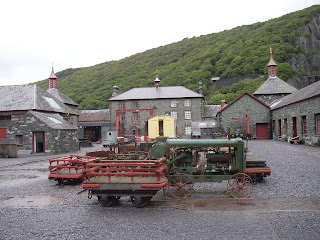My visit to Llanberis gave me the opportunity to visit the Slate Museum at Llanberis where the history of slate mining is well explained in models, film and arifacts. The setting is the workshops and finishing area for the Asheton Smith quarries.
The largest working watermill in Great Britain. According to the information plaque - "50' 5" in diameter, 5' 3" wide, and built around a 12" axle, it was constructed in 1870 by De Winton of Caernarfon, Gwynedd. The original was replaced in 1925 by a Pelton wheel or turbine, (still in use), but remarkably the water wheel was not scrapped. Restored to full working order in 1982, it is powered by water from the opposite side of the valley, carried by a 2' diameter cast iron pipeline."
Dinorwig workshops. "Whilst the surrounding mountains echoed with blasting, this building, Dinorwig workshops, built in 1870, serviced all the needs of the quarry. Over 100 men were employed here - with skills to make the operation self-sufficient. Wood from local trees was lifted in by crane to make trucks and engines for slate transport. In the smithy and foundry, men built and repaired machinery. Pattern makers crafted huge wooden patterns for metal machine parts. The giant water wheel gave power."
Here is a list of the many North Wales slate quarries that once existed. Only a few of them now remain.
How the price of slate has risen in value !
No traitors live here!
This was a common sight at the time of the Great Penrhyn Strike and can be seen in the window of one of the cottages reconstructed at the National Mining Museum at Llanberis. This strike was one of the most bitter in North Wales' industrial history. You can read more about the history of this important strike at the Snowdonia National Park website.This is a terrace of former miner's cottages. The information board at the front reads:
"This terrace of houses, Fron Haul, was built in the village of Tanygrisiau, near Blaenau Ffestiniog, as homes for slate quarrymen. Here, the houses are furnished to reflect important periods in the history of the slate industry.
In no 3 lives a slate worker's family of 1861, crammed alongside their lodgers, exploiting the boom years of slate. No 2 is a house at Bethesda, during the bleak Penrhyn strike and lockout of 1900-03. The family struggles to survive, but a placard in the window says "There is no traitor in this House". No 1 is set in Llanberis in 1969: Dinorwig Quarry has closed, the father has no job, the future is uncertain. No 4 is used for educational projects on the lives of quarrymen and their families."
Interior circa 1870
Interior circa 1970











No comments:
Post a Comment